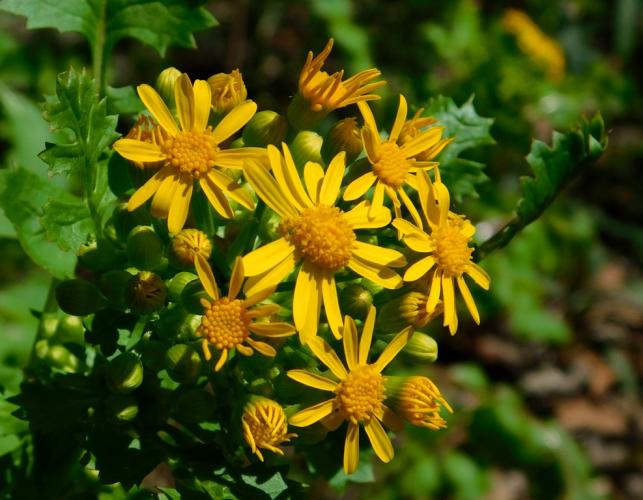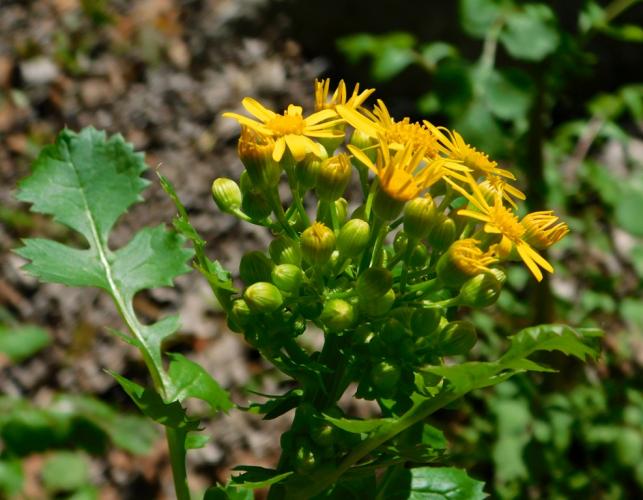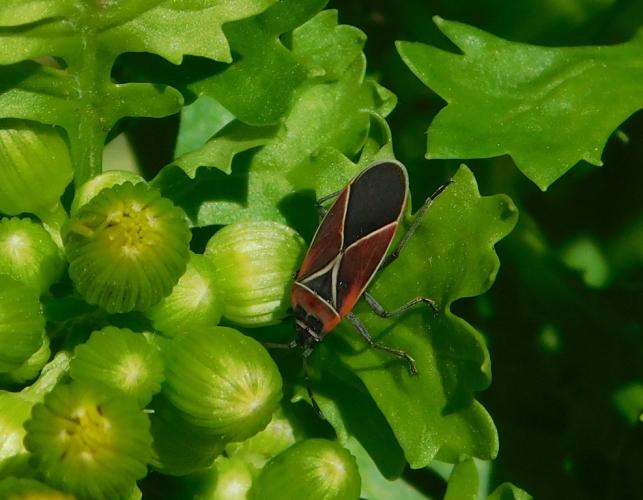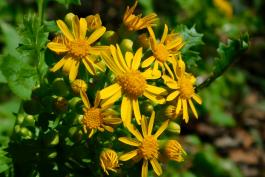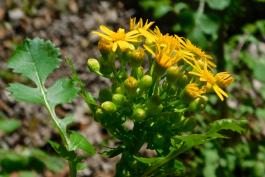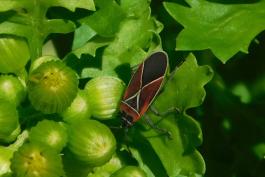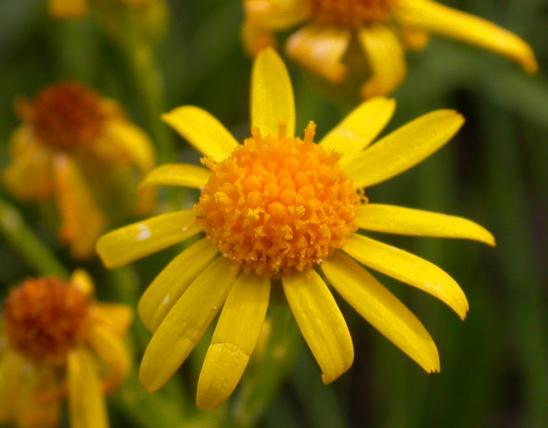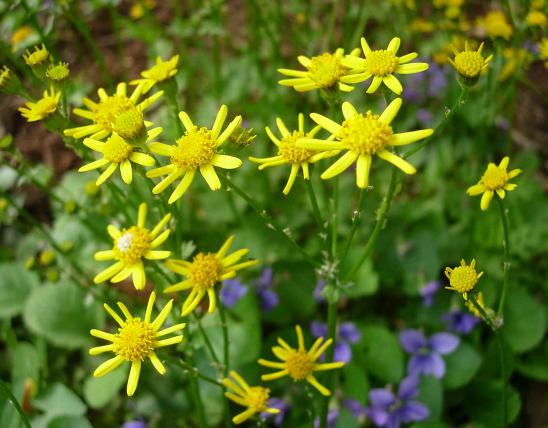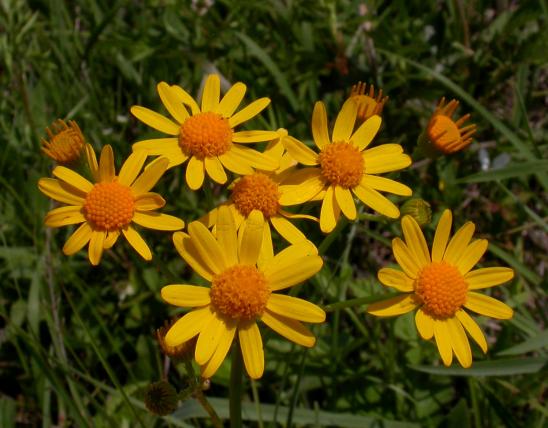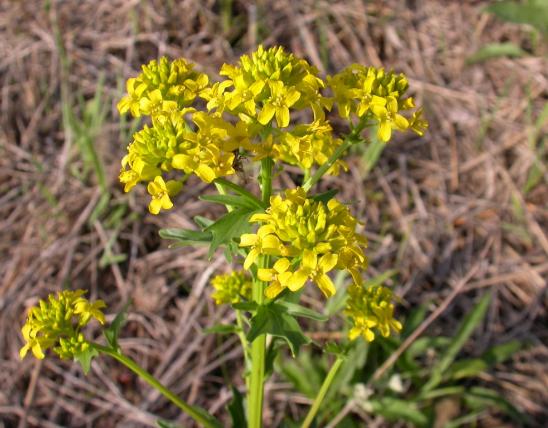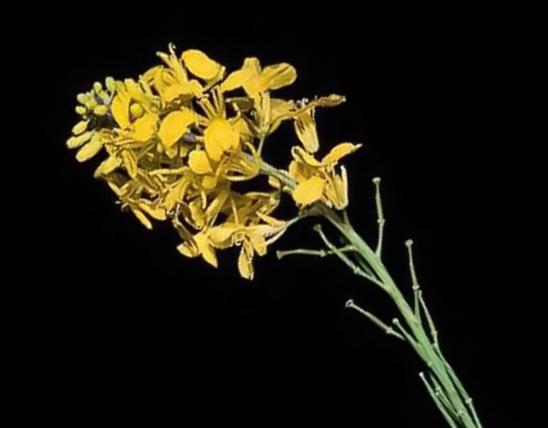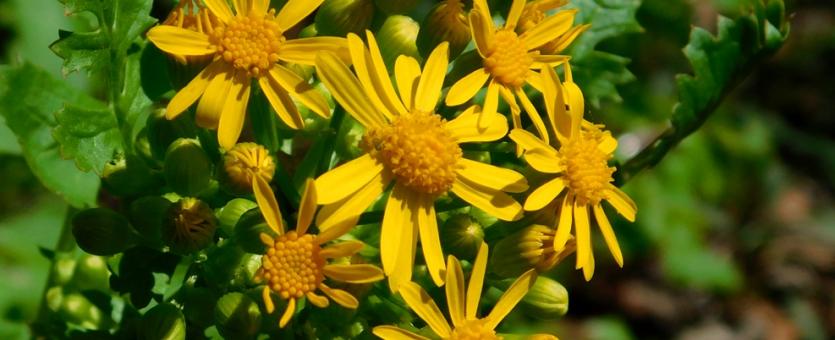
Butterweed, one of Missouri’s seven species of ragworts or groundsels, is the only one that is an annual, has fibrous roots (lacking rhizomes or stolons), usually has only a single, unbranched stalk that is smooth (without hairs), and typically grows in colonies (at times covering acres of floodplain). The stems are heavily ridged and usually inflated or hollow. It usually has no basal leaves at flowering time; the stem leaves, however, are largest at the base of the plant and get gradually smaller up the stem. The blades are deeply pinnately lobed, with toothed margins. Flowers abundant, with rich golden heads with few ray flowers. Blooms April–June.
Learn more about Missouri’s ragworts.
Similar species: Seven Packera species occur in Missouri, plus a number of hybrids having intermediate characteristics that make identification tricky. Generally, the best characters for distinguishing among Missouri’s ragwort species are the leaves, especially the basal leaves, if they are present at flowering time. Butterweed, being the only one that is annual (not perennial) and lacks a basal whorl of leaves at flowering time, stands apart from the others.
From a distance, colonies of blooming butterweed may be misidentified as colonies of yellow rocket (a type of mustard). Indeed, one common name for butterweed, “cressleaf groundsel,” recognizes the foliage’s similarity to cresses and other mustards.
Height: to 3 feet.
Scattered mostly in the Mississippi and Missouri River floodplains and their major tributaries, and in the Bootheel lowlands. Also occurs sporadically elsewhere in the eastern half of the state.
Habitat and Conservation
Occurs in bottomland forests, swamps, banks of streams, rivers, and sloughs, bottomland prairies, and less commonly moist depressions of upland prairies and sand prairies; also in crop fields, fallow fields, railroads, roadsides, and moist, open, disturbed areas.
Status
Native Missouri wildflower.
Plants are toxic if eaten by people, livestock, or other animals.
Missouri’s species in genus Packera used to be grouped with about 3,000 other species into a gigantic genus Senecio. Today, even with the packeras and several other groups split away, Senecio is still a huge genus with more than 1,200 species, mostly in the Old World. Only two species of true senecios have been recorded in Missouri, both introduced/nonnative and uncommon.
Human Connections
Although several species of ragworts have become popular as native wildflowers for gardening, butterweed is rarely if ever cultivated, since it is rather weedy. It spreads by seed. The seeds germinate and sprout in fall, then wait until spring to continue growing.
Ragworts contain toxic pyrrolizidine alkaloid chemicals and are poisonous if eaten. Like many other plants with toxic chemicals, they also have a long history as medicinal plants. Native Americans, settlers, and others have used them for treating a variety of ailments, including delayed and irregular menstruation and complications of childbirth. This is apparently how these plants acquired one of their common names, since they were associated with women’s reproductive health issues.
The common name “butterweed,” which is used for several ragwort species worldwide, is for the yellow color of the flowers.
The genus name, Packera honors Canadian botanist John G. Packer (1929–2019), who was born and raised in England but moved to Edmonton, where at the University of Alberta he became an authority on Arctic and alpine plants and literally wrote the book on the flora of Alberta.
The species name, glabella, is for the glabrous (smooth, not hairy) surfaces of the leaves and other parts of the plant.
Ecosystem Connections
Deer, rabbits, livestock, and other herbivorous mammals tend to avoid ragworts due to toxic pyrrolizidine alkaloid chemicals in the plants’ tissues.
A wide variety of bees, flies, beetles, and other insects visit the flowers for nectar and pollen.
The white-crossed seed bug (Neacoryphus bicrucis) and the caterpillars of a geometrid moth called “the gem” (Orthonama obstipata) are two kinds of insects that feed on ragworts. At least in the case of the seed bug, the plant’s toxic chemicals are stored in the insect’s body, providing it protection from predators.
Butterweed and the gobs of other plants that grow along rivers and streams play an important role in stabilizing the banks against erosion. They also provide important cover for the animals, ranging from insects to birds and mammals, that visit streams for water and to forage and hunt for food.
